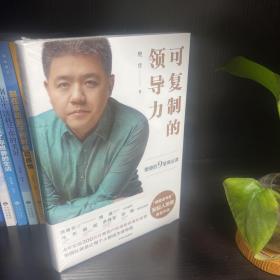
FundamentalChemistryPrinciplesandApplications
正版新书 新华官方库房直发 可开电子发票
¥ 65.66 6.7折 ¥ 98 全新
库存6件
江苏无锡
认证卖家担保交易快速发货售后保障
作者[美]威廉、L.、马斯特顿(William、L.、Masterton) 著
出版社化学工业出版社
出版时间2019-09
版次1
装帧平装
货号文轩12.14
上书时间2024-12-16
- 在售商品 暂无
- 平均发货时间 14小时
- 好评率 暂无
- 店主推荐
- 最新上架
商品详情
- 品相描述:全新
图书标准信息
- 作者 [美]威廉、L.、马斯特顿(William、L.、Masterton) 著
- 出版社 化学工业出版社
- 出版时间 2019-09
- 版次 1
- ISBN 9787122347053
- 定价 98.00元
- 装帧 平装
- 开本 16开
- 纸张 胶版纸
- 页数 445页
- 【内容简介】
-
《Fundamental Chemistry: Principles and Applications》主要参考我国医学类相关专业《基础化学》教学大纲所规定的教学内容改编而成,整合改编后共15章内容,主要包括:原子(Atoms)、电子结构和元素周期表(Electronic Structure and the Periodic Table)、共价键(Covalent Bonding)、热力学(Thermochemistry)、自发反应(Spontaneity of Reaction)、气体的化学平衡(Gaseous Chemical Equilibrium)、反应速率(Rate of Reaction)、液体和固体(Liquids and Solids)、溶液(Solutions)、酸和碱(Acids and Bases)、酸碱平衡(Equilibria in Acid-Base Solutions)、沉淀溶解平衡(Precipitation Equilibrium)、电化学(Electrochemistry)、配位化合物(Complex Ions)以及核反应(Nuclear Reactions)。在本书的改编过程中,在尊重原教材版权的基础上,编者在遵循适合我国教材所涵盖的知识体系的同时,尽可能体现原书的风格和特点,使内容更加精炼紧凑。
《Fundamental Chemistry: Principles and Applications》可供国内基础、临床、口腔、麻醉、预防、护理、生物工程、药学等医学类相关专业基础化学类课程的双语教学和留学生教学使用,也可供其他专业基础化学双语教学的师生及科技工作者用作参考书。 - 【作者简介】
-
傅迎,大连医科大学,教授、硕士研究生导师,< 授课方面>
1、本科药学、临床药学专业:无机化学与物理化学
2、本科、本硕连读(5+3)临床医学专业:基础化学
3、本科留学生临床医学专业(全英):Basic Chemistry
4、本科卫生检验与检疫专业:食品理化检验
5、本科药学、临床药学、临床检验等专业:仪器分析
< 科研方面>
研究方向:分子生物学技术在临床检验应用中的研究
1、2008~2017年,省立项课题:基于代谢组学的中药复方活性成分的分析语药效评价的研究等三项,主要参与人。
2、2009年国家自然科学基金:蛋白质组学策略筛选淋巴道转移特征性分泌蛋白质标记物,30971539;主要参与人。
3、2012年中华医学会医学教育分会、中国高等教育学会医学教育专业委员会年2012度医学教育研究立项课题:2012-GW-10 国内外医学基础化学教育的比较研究 ,项目主持人。
4、2015年大连医科大学留学生全英文授课品牌课:项目主持人
5、2017辽宁省教育科学规划立项课题:医学检验虚拟仿真实验教学的建设与实践,JG14DB139,主要参与人
6、SCI收录学术论文多篇,教学论文多篇。 - 【目录】
-
1 Atoms 1
1-1 Atoms and the Atomic Theory 1
1-2 Components of the Atom 2
The Human Side: John Dalton 3
1-3 Quantitative Properties of the Atom 5
1-4 Introduction to the Periodic Table 11
Beyond The Classroom: Mastering the Peri’god’ic Table 14
Summary Problems 16
Questions and Problems 16
2 Electronic Structure and the Periodic Table 19
2-1 Light, Photon Energies, and Atomic Spectra 20
2-2 The Hydrogen Atom 25
2-3 Quantum Numbers 28
2-4 Atomic Orbitals; Shapes and Sizes 32
2-5 Electron Configurations in Atoms 33
The Human Side: Glenn Theodore Seaborg 37
2-6 Orbital Diagrams of Atoms 38
2-7 Electron Arrangements in Monatomic Ions 40
2-8 Periodic Trends in the Properties of Atoms 43
Beyond The Classroom: Why Do Lobsters Turn Red When Cooked 47
Summary Problems 49
Questions and Problems 49
3 Covalent Bonding 52
3-1 Lewis Structures; The Octet Rule 53
The Human Side: Gilbert Newton Lewis 62
3-2 Molecular Geometry 62
3-3 Polarity of Molecules 70
3-4 Atomic Orbitals; Hybridization 73
Beyond The Classroom: The Noble Gases 80
Summary Problems 81
Questions and Problems 81
4 Thermochemistry 85
4-1 Principles of Heat Flow 86
4-2 Measurement of Heat Flow; Calorimetry 90
4-3 Enthalpy 93
4-4 Thermochemical Equations 94
4-5 Enthalpies of Formation 100
4-6 Bond Enthalpy 105
4-7 The First Law of Thermodynamics 107
Beyond The Classroom: Energy Balance in the Human Body 111
Summary Problems 113
Questions and Problems 113
5 Spontaneity of Reaction 116
5-1 Spontaneous Processes 117
5-2 Entropy, S 119
5-3 Free Energy, G 123
The Human Side: J. Willard Gibbs 125
5-4 Standard Free Energy Change, ΔG 125
5-5 Effect of Temperature, Pressure, and Concentration on Reaction Spontaneity 129
5-6 The Free Energy Change and the Equilibrium Constant 134
5-7 Additivity of Free Energy Changes; Coupled Reactions 135
Beyond The Classroom: Rubber Elasticity: An Entropic Phenomenon 137
Summary Problems 139
Questions and Problems 139
6 Gaseous Chemical Equilibrium 144
6-1 The N2O4–NO2 Equilibrium System 145
6-2 The Equilibrium Constant Expression 148
6-3 Determination of K 153
6-4 Applications of the Equilibrium Constant 156
6-5 Effect of Changes in Conditions on an Equilibrium System 161
Beyond The Classroom: An Industrial Application of Gaseous Equilibrium 166
Summary Problems 168
Questions and Problems 169
7 Rate of Reaction 171
7-1 Meaning of Reaction Rate 171
7-2 Reaction Rate and Concentration 174
7-3 Reactant Concentration and Time 180
7-4 Models for Reaction Rate 186
The Human Side: Henry Eyring 189
7-5 Reaction Rate and Temperature 190
7-6 Catalysis 193
7-7 Reaction Mechanisms 195
Beyond The Classroom: The Ozone Story 199
Summary Problems 201
Questions and Problems 202
8 Liquids and Solids 206
8-1 Comparing Solids, Liquids, and Gases 206
8-2 Liquid-Vapor Equilibrium 207
8-3 Phase Diagrams 213
8-4 Molecular Substances; Intermolecular Forces 216
Beyond The Classroom: Supercritical Carbon Dioxide 222
Summary Problems 224
Questions and Problems 224
9 Solutions 227
9-1 Concentration Units 227
9-2 Principles of Solubility 236
9-3 Colligative Properties of Nonelectrolytes 241
9-4 Colligative Properties of Electrolytes 250
Beyond The Classroom: Maple Syrup 252
Summary Problems 254
Questions and Problems 254
10 Acids and Bases 257
10-1 Br nsted-Lowry Acid-Base Model 257
10-2 The Ion Product of Water 259
10-3 pH and pOH 259
10-4 Weak Acids and Their Equilibrium Constants 265
10-5 Weak Bases and Their Equilibrium Constants 274
10-6 Acid-Base Properties of Salt Solutions 278
10-7 Extending the Concept of Acids and Bases: The Lewis Model 281
Beyond The Classroom: Organic Acids and Bases 282
Summary Problems 285
Questions and Problems 285
11 Equilibria in Acid-Base Solutions 288
11-1 Buffers 288
11-2 Acid-Base Indicators 299
11-3 Acid-Base Titrations 302
Beyond The Classroom: Acid Rain 311
Summary Problems 313
Questions and Problems 313
12 Precipitation Equilibria 316
12-1 Solubility; Solubility Product Constant (Ksp) 316
12-2 Precipitate Formation 323
12-3 Dissolving Precipitates 327
Beyond The Classroom: Qualitative Analysis 331
Summary Problems 333
Questions and Problems 334
13 Electrochemistry 337
13-1 Oxidation-Reduction Reactions Revisited 338
13-2 Voltaic Cells 342
13-3 Standard Voltages 346
13-4 Relations Between E , DG , and K 353
13-5 Effect of Concentration on Voltage 355
Beyond The Classroom: Fuel Cells: The Next Step in Chemical-to-Electrical-Energy Conversion 359
Summary Problems 361
Questions and Problems 362
14 Complex Ions 366
14-1 Composition of Complex Ions 367
14-2 Naming Complex Ions and Coordination Compounds 371
14-3 Geometry of Complex Ions 373
14-4 Electronic Structure of Complex Ions 377
The Human Side: Alfred Werner 377
14-5 Complex Ion Equilibria; Formation Constant (Kf) 382
Beyond The Classroom: Chelates: Natural and Synthetic 384
Summary Problems 386
Questions and Problems 387
15 Nuclear Reactions 389
15-1 Nuclear Stability 389
15-2 Radioactivity 391
The Human Side: Marie and Pierre Curie with daughter Irene, at their home near Paris 397
15-3 Rate of Radioactive Decay 397
15-4 Mass-Energy Relations 400
15-5 Nuclear Fission 404
15-6 Nuclear Fusion 407
Beyond The Classroom: Biological Effects of Radiation 409
Summary Problems 410
Questions and Problems 410
Appendices
Appendix 1 Units, Constants and Reference Data 413
Appendix 2 Properties of the Elements 419
Appendix 3 Exponents and Logarithms 421
Appendix 4 Molecular Orbitals 426
Appendix 5 Answers to All Questions and Problems 431
Conversion Factors 443
Table of Atomic Masses 444
IUPAC Periodic Table of the Elements 445
点击展开
点击收起
— 没有更多了 —
















以下为对购买帮助不大的评价